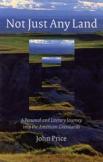Repairing the Prairie
Books about America’s grasslands have traditionally been written somewhere else. John Price, a writer of nature and spiritual essays from Iowa who teaches in Nebraska, shows one way to stay at home and find success as a responsible grasslands resident, if not necessarily as a best-selling author.
We can easily agree with Price that these lands should be restored. Believing they will be is more difficult, but Price, in striving for faith and community, finds them while attending to the land: It was a faith made all the more significant by taking place in a state where, less than a decade ago during the farm crisis, so many communities had been divided and damaged by economic battles over the land. Iowa is still recovering from those difficult years, much has been lost, but the prairie we are building here, together, is perhaps evidence that as the land can heal so, too, can we.
Not Just Any Land recounts a time in 1994, when the author made a personal pilgrimage to South Dakota’s Badlands and visited four grasslands authors, and reports on epiphanies in 1996, when he gathered seeds for prairie restoration and saw buffalo in Iowa. Beginning and concluding with memoir and creative nonfiction, and blending these with extensive interviews, Price, with his informal and upbeat style, lightened with self-deprecating humor, depicts both the grief and hope needed for the healing he envisions.
Price’s camping trip in South Dakota, which he had visited as a child, begins his journey. Identifying his feelings about this land is his first task, followed by asking what it means for a conscientious writer to be at home here. Finally, he wonders if we’ll find the collective wisdom to fully heal this broken land. Despite human cross-cultural conflicts and damage done to native grasses and animals, Price finds in other literature on the grasslands the hope that a writer might seek what Wendell Berry called the beloved community, with its consolation, forgiveness and redemption.
Soil erosion, the farm crisis and the angst expressed recently by ultraconservative Midwesterners can all be seen as effects of the loss of grasses. While Price does not spell out all of these connections, they are clear enough in his assessment of environmental problems and in his prescription for writers and other thoughtful readers: find a spiritual community and ask what the land demands.
Like other books lamenting the state of the American grasslands, which have helped feed people around the world, this work sounds an alarm. It also offers a study of how four writers (Dan O’Brien, Linda Hasselstrom, William Least Heat-Moon and Mary Swander) have managed to be faithful to the land and themselves. The integrity Price uncovers is set against loneliness, human foibles and such obstacles as frostbite and unhealthy environmental conditions.
Data and background information on the damage to the grasslands are well placed in the first of the six chapters. Price recounts the recent history of this area, describes literature the area has inspired and begins telling his personal story and some family history.
The author’s text incorporates motifs and assertions from other writers, along with biblical allusions, to build and support his questions and answers regarding the healing of the grasslands and its people. He points to several Europeans who came to America and left accounts of their first encounters with the wild prairies, accounts that created a complex portrait of fear and awe, wonder and disdain. He devotes five pages to Hamlin Garland, the writer born in Wisconsin in 1860, to whose story he returns often for inspiration. Price’s passion about the grasslands echoes Garland’s fervent desire for farming reform and unplowed grasslands.
Besides being a scholarly book, Not Just Any Land (the title is taken, apparently, from Hasselstrom’s description of her family ranch) is a tripartite memoir that includes autobiography, literary criticism and nature writing, especially informative for anyone familiar with the four authors or anyone wanting an inside look at the lives of these authors of significant, ground-breaking nonfiction.
Price’s narrative, however, is less riveting than the books of the four authors interviewed. Ms. Hasselstrom, for example, shows what it means to know and live with the land and to respond to it, defying certain preconceptions about cattle ranching. Given the altered lands of which Price writes, Not Just Any Land, nevertheless, is a remarkable book.
This article also appeared in print, under the headline “Repairing the Prairie,” in the November 22, 2004, issue.








